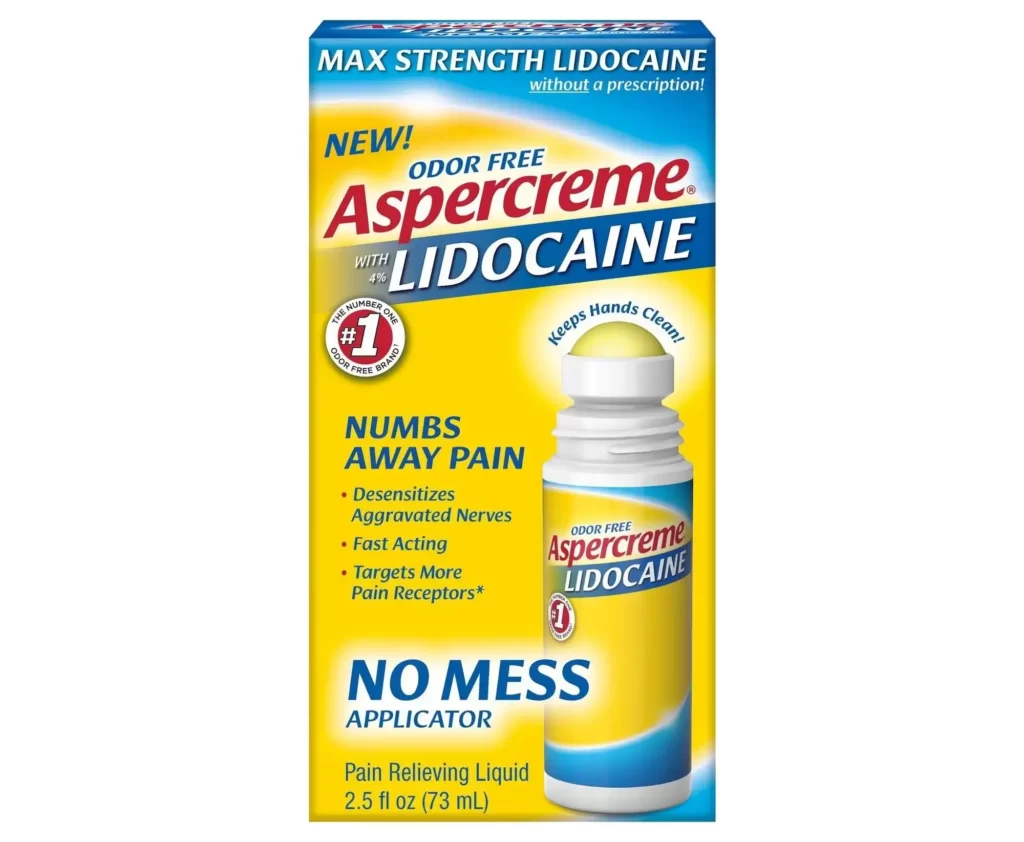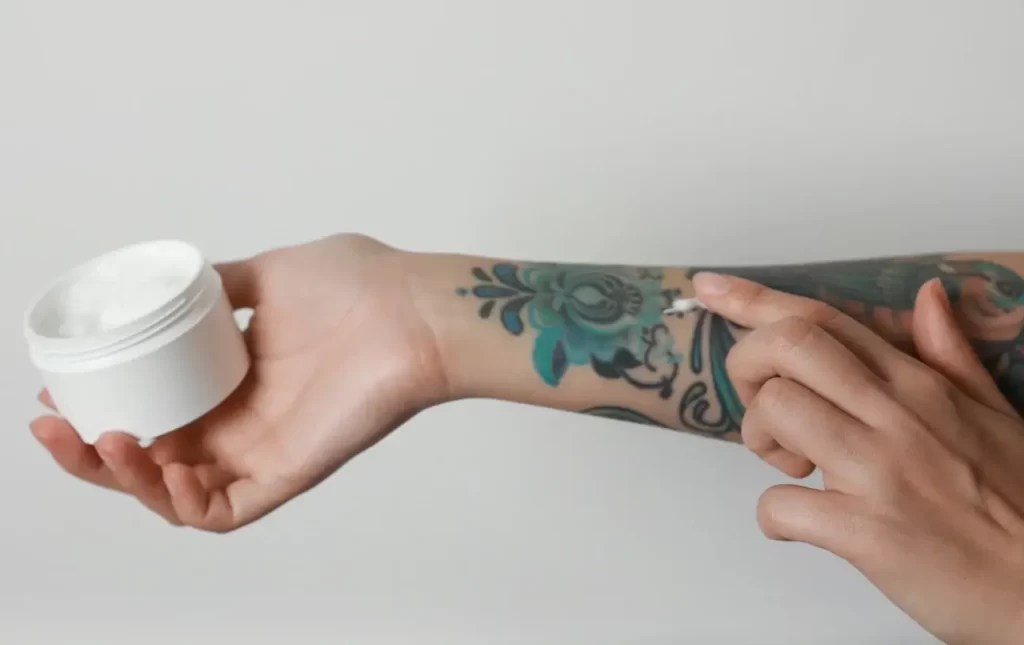When considering the discomfort and pain associated with getting a tattoo, many people ponder, “Can I use Aspercreme with lidocaine before a tattoo?”
Aspercreme, an over-the-counter pain relief option, is often looked at for its effectiveness in easing the discomfort of tattoos.
Its suitability largely depends on the location of the tattoo and the individual’s pain tolerance.
While exploring the benefits of Aspercreme for tattoos, it’s crucial to weigh all available options to ensure a comfortable tattoo experience.
What Is Aspercreme?
Aspercreme is a widely recognized topical analgesic, known for its active ingredients like menthol and camphor. It is primarily used to provide temporary relief from minor aches and pains.
Often, individuals suffering from conditions like arthritis or those with sore muscles turn to Aspercreme for its soothing properties. However, its application is not without caution.
The product can potentially cause irritation or inflammation, and there are concerns about its chemical content potentially leading to damage in skin quality and the vibrancy of colors, especially in sensitive areas like those with tattoos.
Is Aspercreme Good For Tattoos?
When deliberating on the use of Aspercreme as a pain relief cream for tattoos, its key component, 4% lidocaine, plays a significant role.
Lidocaine, a local anesthetic, is known for its ability to numb the skin and reduce pain by blocking nerves from transmitting pain signals to the brain.
Despite these properties, it is crucial to note that Aspercreme is not specifically approved by the FDA for tattoo-related use.
The success of Aspercreme in alleviating tattoo pain largely depends on factors like an individual’s pain tolerance, the location, size, and complexity of the tattoo design.
To achieve maximum pain relief, it is essential to follow the instructions for use accurately.
While Aspercreme has been reported to provide relief, each individual’s experience may vary, and it should be used with caution, especially considering the unique demands of tattooed skin.

Can I Use Aspercreme With Lidocaine Before A Tattoo?
Using Aspercreme for tattoos requires caution. The instructions on the package should be closely followed, applying only a thin layer to the tattooed area.
It’s vital to avoid broken skin, and if your skin becomes irritated, usage should be discontinued immediately.
How To Use Lidocaine For Tattoos?
Using lidocaine as a topical anesthetic for tattoos can help numb the skin during the tattoo procedure. It works by blocking the nerve signals that transmit pain signals to the brain.
Before application, ensure that the skin is clean and free from oils and lotions. It’s commonly swabbed with alcohol to disinfect it.
The cream or gel should be applied and rubbed in to ensure it’s evenly distributed. This helps numb the skin, making the tattooing process more comfortable.
After the tattoo is complete, it can be removed with soap and water. When used according to directions, it’s a safe and effective way to reduce tattoo-related discomfort and potential complications.
How Long For Aspercreme To Work?
When considering using Aspercreme before getting a tattoo, it’s essential to understand how long it takes for this topical pain reliever to work.
Generally, Aspercreme begins to alleviate pain within 10-15 minutes after application.
This time frame can vary slightly from individual to individual, depending on the severity of the pain and the body’s response to the medication.
Aspercreme’s active ingredient, Trolamine Salicylate, works by inhibiting the production of prostaglandins, chemicals in the body that cause pain and inflammation.
It’s available in various forms like gels, creams, lotions, and patches, offering flexibility in application. For a tattoo, you would typically apply it to the affected area.
It’s important to use it as directed, usually not more than three to four times per day, and not exceeding 12 hours of usage in total.
If you experience any skin irritation, it’s crucial to discontinue use immediately and contact your healthcare provider for guidance.
Remember, while Aspercreme can offer relief, it’s not instantaneous, and its effectiveness can vary based on individual skin types and pain levels.
Lidocaine After Tattoo
- Lidocaine is a local anesthetic that effectively numbs the area where it is applied, commonly used on tattoos to reduce pain and discomfort.
- It works by temporarily blocking the nerves from sending pain signals to the brain, providing relief during the healing process of a tattoo.
- Lidocaine comes in various forms such as creams, gels, sprays, and injections, allowing for direct application to the tattooed area.
- The effects of lidocaine typically begin within minutes and can last for several hours. Always follow the directions on the product label for safe use.
- Be aware of potential side effects like allergic reactions, skin irritation, and dizziness. If symptoms are more than mild, seek medical advice.
Aspercreme With Lidocaine For Tattoos Reviews
When considering Aspercreme with Lidocaine for a new tattoo, many have found it to be a helpful topical numbing agent.
This cream is designed to soothe the skin while providing pain relief. Key ingredients like Lidocaine and menthol not only numb the area but also offer a cool sensation, helping to soothe the skin post-tattooing.
Users appreciate its non-greasy, fast-absorbing qualities, ensuring it doesn’t interfere with the tattooing process.
To use, simply apply a thin layer to the area before the session. Many reviewers have noted its effectiveness in reducing pain, making the experience more bearable.
However, it’s important to use it as directed and not overdo it. A test on a small area of the skin is recommended to check for any reaction before applying it to a larger area.
Aspercreme is not only a numbing cream but also a topical anesthetic, making it useful for a variety of skin conditions beyond tattooing.
It’s effective for piercing, other body modification procedures, as well as for sunburns, insect bites, and minor skin irritations.
To apply, first clean the area with soap and water, then rub in a generous amount of Aspercreme. If needed, cover with a bandage for up to one hour before removing.
This method has been recommended by many for achieving the best relief during and after getting a tattoo.
Apply The Aspercreme Product To Your Tattoo As Directed
When using Aspercreme as a topical pain reliever for your tattoo, it’s crucial to apply the product exactly as directed by the manufacturer.
Whether it’s in the form of a cream, gel, or spray, Aspercreme is designed to alleviate discomfort in various conditions like joint and muscle aches, arthritis, sprains, strains, and bruises.
It’s important to note, however, that it is not intended for more serious conditions such as post-surgery pain, fibromyalgia, or neuropathy.
The key ingredients in Aspercreme, such as menthol and camphor, provide a cooling and numbing sensation that can be quite soothing on the skin.
This makes it a gentle yet effective aid in the tattoo process, helping to soothe the discomfort associated with getting a new tattoo.
Remember to apply it gently to the tattooed tissue, and follow any specific guidelines provided by the product label or your tattoo artist for the best results.

How To Apply Aspercreme Before Tattoo?
- Clean the area where the tattoo will be placed. Ensuring the skin is thoroughly clean reduces the risk of infection and helps the Aspercreme be more effectively absorbed.
- Apply a small amount of Aspercreme and spread the cream evenly over the skin. It’s important to avoid using too much cream, as it can rub off during the tattooing process.
- Wait for about 30 minutes after application for the pain relief effect to set in before starting the tattooing.
- If dealing with a particularly long or painful tattoo session, follow the instructions on the Aspercreme packaging about how often you can reapply it safely.
Benefits Of Using Aspercreme For Tattoos
- Reduced Pain: The inclusion of lidocaine in Aspercreme helps to effectively numb the skin, making the tattooing process much more comfortable and less stressful.
- Increased Comfort: With reduced pain, getting a tattoo becomes a more enjoyable and less intimidating experience, particularly for those who are new to tattoos.
- Longer Sessions: The discomfort reduction can extend the length of tattoo sessions, allowing for larger designs or more complex work without undue pain.
Risks Of Using Aspercreme On A Tattoo
Using Aspercreme on a tattoo, while providing benefits, also poses some potential risks:
- Irritation: Some individuals may experience skin irritation or allergic reactions to the product, so it’s essential to perform a patch test first.
- Color Fading: Over a long period, Aspercreme may wash off the tattoo ink, leading to color fading.
- Dry Skin: Aspercreme can dry out the skin, potentially causing it to crack or peel in the tattooed area.
- Ingredients: Check the product for parabens, which have been associated with certain cancers when used over long-term.
- Healing: While it provides a barrier against pain, it may also hinder the flow of oxygen and nutrients to the wound site, potentially affecting the healing process.
It’s crucial to weigh these risks against the benefits and consult with a tattoo artist or dermatologist before using Aspercreme on your tattoo.
When considering using Aspercreme for your tattoos, it’s essential to exercise caution and seek advice from a dermatologist or tattoo artist.
While it can offer temporary relief from soreness and inflammation, its risks may outweigh the benefits in some cases.
Factors such as tattoo size, color, and location should be considered, along with the instructions for application and usage.
Using it in moderation and with proper care can help mitigate potential discomfort and itching.
It’s crucial to explore other options and make an informed decision based on your specific needs and circumstances.
Aspercreme Vs Other Pain Relief Options For Tattoos
When considering Aspercreme for tattoos, it’s important to understand its role in pain relief. As a topical application, it’s designed to reduce pain by blocking nerve signals in the skin.
This can be particularly beneficial during the tattooing process, where managing pain can extend the length of sessions and minimize discomfort.
However, like all numbing creams, Aspercreme contains lidocaine, which, while generally safe, can cause side effects like skin irritation or allergic reactions.
It’s always wise to have a doctor’s visit before trying new products, especially when it comes to skin treatments.
1. Painkillers
In contrast, painkillers such as ibuprofen and acetaminophen are common choices in the market. They provide adequate relief for many, but not without potential drawbacks.
High doses over long periods can lead to stomach upset or liver damage. These risks highlight why it’s crucial to balance effectiveness with ease of use and safety.
2. Numbing Creams
Other numbing creams on the market, besides Aspercreme, are often considered by those seeking tattoo pain relief.
Their effectiveness varies, and they share similar risks of skin irritation and allergic reactions.
Choosing the right product often involves personal research and consultation with tattoo artists.
3. Local Anesthesia
Some opt for local anesthesia, typically administered through injections by healthcare professionals.
This method can be very effective in managing pain, but it’s often more expensive and not always accessible.
Additionally, those with an aversion to needles may find this option uncomfortable or stressful.

Personal Experience
From my experience, many clients express concerns about moving or flinching during their tattoo session.
While Aspercreme can offer a level of comfort, it’s crucial to weigh all options. Each method of pain management has its pros and cons, and what works for one person may not for another.
It’s about finding a balance that allows you to endure the process while not compromising on safety or effectiveness.
Other Uses Of Aspercreme For Pain Relief
1. Arthritis Pain Relief
When it comes to arthritis, the pain, stiffness, and swelling in the joints can be quite debilitating. Aspercreme, when applied to the affected area, can help.
It contains lidocaine, a component known to effectively numb the discomfort, offering a reprieve from the constant ache of arthritis.
2. Back Pain Relief
Back pain can severely impact daily life, making even simple daily activities a challenge. Here, Aspercreme serves as a boon.
By applying it to the affected area, the lidocaine works to numb the discomfort, allowing individuals to carry on with their day with less pain.
3. Muscle Pain Relief
Muscle pain often results from overuse or injury. In these cases, Aspercreme can be a reliable ally.
When applied to the sore muscles, its lidocaine content helps numb the area, easing the discomfort and helping individuals move more freely.
4. Sports Injury Relief
For athletes, sports injuries like strains, sprains, or even more serious injuries can hinder training and competing.
Aspercreme, when applied to these injuries, can provide much-needed relief. The lidocaine in Aspercreme helps numb the discomfort, aiding in the recovery process.
5. Post-Surgery Pain Relief
Following surgery, managing post-surgery pain is crucial for a smooth recovery process. Aspercreme can be an effective part of pain management.
Applying it to the affected area, as per doctor’s instructions, can help numb the pain, making the recovery more comfortable.
Where Not To Use Aspercreme?
While Aspercreme is a popular choice for pain relief, it’s crucial to know where not to use it, especially in the context of tattoos and body piercings.
The active ingredients in the cream can irritate sensitive skin, leading to redness, itching, or even swelling.
This irritation can interfere with the healing process, potentially causing infection or affecting the color and design of the tattoo, making it appear blurry.
It’s always best to consult with your tattoo artist or a healthcare provider on how to manage pain effectively.
They might recommend alternatives like over-the-counter options such as ibuprofen or acetaminophen, cold compresses, or other topical creams that are safer for tattoo aftercare.
Remember, when it comes to tattoos, the integrity of the ink and the health of your skin should always be a priority.
Who Should Not Use Aspercreme With Lidocaine?
Aspercreme with Lidocaine, while beneficial for many, is not suitable for everyone. Individuals with sensitive skin or broken skin should avoid its use due to the heightened risk of irritation.
Those with specific medical conditions such as diabetes or poor blood circulation need to be cautious, as these conditions can intensify the cream’s effects.
Medications that may interact with Aspercreme’s ingredients pose another concern. It is especially important for those who are allergic to lidocaine to steer clear of this product.
Moreover, it’s advised that pregnant women, nursing mothers, and anyone under 18 years old should not use Aspercreme without prior medical advice.
The directions on the label should be followed diligently, and consulting with a health care provider is a crucial step in ensuring both health and safety.
Remember, when it comes to managing pain before getting a tattoo, understanding your own health and the risks associated with pain relief options is key.
Is Aspercreme A Topical Steroid?
Aspercreme is not a topical steroid. Instead, it is an over-the-counter medication known for providing relief from minor aches and pains.
It does contain menthol, which offers a cooling sensation that can be soothing on the skin, particularly when dealing with tattoo pain and discomfort.
However, it’s always recommended to consult with a doctor or tattoo artist before applying any medications or creams to a new tattoo.
For effective tattoo aftercare, healthcare professionals often recommend using antibiotic ointments, mild soaps, and moisturizers to keep the tattoo area hydrated.
This helps in preventing scabs, skin irritation, and rash. It’s also important to avoid direct sunlight and swimming until the tattoo has completely healed.
While Aspercreme can be helpful for temporary relief, long-term use should be approached with caution.
If you experience persistent pain, rash, or signs of an infection, it is essential to seek medical advice from a healthcare professional to ensure your tattoo heals properly and to avoid any complications.
Is Aspercreme A Muscle Relaxer?
Aspercreme is not a muscle relaxer; it is an over-the-counter topical analgesic used primarily for relieving minor aches and pains.
Its active ingredient, lidocaine, works by numbing the area where it is applied topically, but it does not have muscle relaxing effects.
Aspercreme is designed for specific uses as indicated on its label, and any application beyond that should be discussed with a healthcare provider to ensure safety and effectiveness, especially when considering its use before getting a tattoo.
How Quickly Does Aspercreme Work?
Discussing Aspercreme in the context of tattoos, it’s important to clarify that it is not a muscle relaxer but an over-the-counter topical analgesic.
Its active ingredient, trolamine salicylate, primarily offers relief from pain and inflammation.
When applied, it creates a cooling sensation and is generally considered safe for topical use.
However, it’s not without potential risks, as it penetrates the skin and can enter the bloodstream.
Aspercreme’s effectiveness in providing relief can be noticeable within minutes of application, although the results can vary from person to person and depend on the severity of the discomfort.
For mild discomfort, it can be a suitable substitute, but it should never replace medical advice or treatment.
If using Aspercreme for pain relief post-tattoo, it’s advisable to seek professional advice from a doctor or tattoo artist, especially if there are signs of infection, redness, swelling, increased pain, or fever.
In such cases, immediate medical attention is crucial to ensure that your tattoo remains healthy and safe.

FAQs About Can I Use Aspercreme With Lidocaine Before A Tattoo
1. Will Aspercreme Help With Tattoos?
Aspercreme, while effective for temporary relief of muscle aches, is not an ideal aftercare cream or ointment for tattoos. Formulated with menthol and other ingredients, it may irritate the skin and lacks long-term protection for healing wounds.
2. Can I Use Aspercreme If My Tattoo Itches?
Using Aspercreme on itchy tattoos is not advisable. Its menthol content and other potential irritants may exacerbate the itching and irritation of recently tattooed skin. Opt for a gentle moisturizer designed for tattoo aftercare to soothe the itchiness.
3. Is Aspercreme Safe To Use Around My Old Tattoos?
Using Aspercreme around old tattoos is generally safe, but it’s wise to first apply a small amount on a patch of skin near the tattoo to test for any burning or stinging sensation.
While its menthol content is similar to that in many muscle rubs, unexpected irritation can occur, especially if the tattoo is not fully freshly healed. Always prioritize proper tattoo aftercare to maintain the integrity of the ink.
4. Can I Use Aspercreme As Numbing Cream?
Aspercreme is generally considered safe for use around old tattoos. However, it’s prudent to apply a small amount on a patch of skin near the tattoo as a test, especially if the area isn’t completely freshly healed.
This precaution helps detect any potential burning or stinging sensation that might occur, a reaction sometimes seen with products containing menthol, like many muscle rubs. Observing for any signs of irritation is a key step in effective tattoo aftercare and ensuring the longevity and quality of the ink.
5. Can You Use Lidocaine Cream For Tattooing?
Using lidocaine cream for tattooing is feasible due to its numbing effect on the skin, which can lessen pain during the procedure by blocking nerve signals to the brain.
However, it’s essential to consult a doctor or pharmacist to confirm if it’s suitable for your skin type and the specific tattoo process. Always adhere to the directions on the packaging and be aware of potential risks and adverse effects associated with its use.
6. Can I Use Other Topical Anesthetics For Tattoos?
When considering the use of topical anesthetics for tattooing, alternatives like benzocaine or tetracaine can be explored. However, it is crucial to consult with a doctor or pharmacist prior to application.
These professionals can provide guidance on whether these anesthetics are suitable for your skin type and the specific tattoo process. They can also warn about possible irritation or allergic reactions.
Always follow the instructions on the packaging carefully. If you are pregnant or nursing, consulting a healthcare professional is even more critical.
Adhering to the directions as recommended can minimize side effects while maximizing the numbing effect. Planning ahead with the right topical anesthetic can make your tattoo experience more comfortable.
7. Is Aspercreme The Same As Voltaren?
Aspercreme and Voltaren are both topical analgesics, but they differ significantly in composition and purpose. Aspercreme often contains menthol, camphor, or eucalyptus oil, and is primarily used for minor muscle aches and pains in joints and muscles.
On the other hand, Voltaren’s active ingredient is Diclofenac sodium, a NSAID that targets inflammation, making it a common choice for managing arthritis.
While both creams provide relief, their ingredients, uses, and side effects vary. It’s crucial to consult a healthcare provider before using any medication as part of your tattoo procedure.
They can advise on the best option, whether it’s Aspercreme, Voltaren, or another OTC medication like ibuprofen, to manage pain and discomfort.
8. How Often Can Aspercreme Cream Be Used For Tattoos?
For tattoos, Aspercreme cream can be used every other day for pain management.
9. What Are Some Of The Most Common Side Effects Of Using Aspercreme Cream For Tattoos?
Using Aspercreme cream for tattoos may result in some common side effects, including mild skin irritation and redness.
10. How Long Does Aspercreme Last?
The duration of Aspercreme’s effects can vary from person to person. Typically, it provides temporary relief from pain and discomfort for a few hours. It’s essential to follow the instructions on the product label for the recommended frequency of application.
11. Does Aspercreme Numb The Skin?
Yes, Aspercreme contains active ingredients like lidocaine that have numbing properties. When applied topically to the skin, it can help numb the area and reduce pain or discomfort.
12. Can You Use Aspercreme Before A Tattoo?
Yes, you can use Aspercreme before getting a tattoo to help manage pain and discomfort during the tattooing process. It’s essential to follow the product’s instructions and consult with your tattoo artist for their recommendations.
13. What Numbing Cream Is Good For Tattoos?
Aspercreme is one of the numbing creams that can be used for tattoos. Other numbing creams, such as those containing lidocaine or benzocaine, are also commonly used by individuals to numb the skin before getting a tattoo. It’s advisable to consult with your tattoo artist for their preferred numbing cream or ointment.
14. Does Aspercreme Work For Tattoos?
Yes, Aspercreme can work effectively for tattoos by providing temporary relief from pain and discomfort during the tattooing process. However, its effectiveness may vary from person to person, and it’s essential to follow the product’s instructions.
15. Is Aspercreme Good For Tattoo Numbing?
Aspercreme can be a good option for tattoo numbing, as it contains active ingredients like lidocaine that help numb the skin. It can make the tattooing process more comfortable for individuals who may experience pain or discomfort. Consult with your tattoo artist for their recommendations on using Aspercreme for numbing.
Final Thoughts
In conclusion, can I use Aspercreme with lidocaine before a tattoo is a question many individuals ask when considering ways to make the tattooing process more comfortable.
As discussed, Aspercreme, with its pain relief properties, can be a valuable option to reduce pain and discomfort during the tattooing process.
By following the instructions provided and consulting with a tattoo artist, it can be an effective option to make the tattoo experience less painful and more successful.
Whether you’re getting your first tattoo or adding to your collection, considering the use of Aspercreme with lidocaine can contribute to a more comfortable tattooing process.
You May Also Like To Read:
- What Happens If You Use Scented Soap On A Tattoo: Surprising Truths Unveiled!
- Accidentally Ripped Off Tattoo Scab? Stay Calm And Follow These Steps
- Expert Insights: Why Tattoo Lines Thicker After Healing Demystified
- Do Blue Ink Tattoos Hold Up Well Over Time: The Ultimate Guide
- How Long After A Tattoo Can I Have Surgery? Understanding The Essential Wait Period
- The Enigma Solved: When Can I Use Scented Lotion On My Tattoo?
- Tegaderm Vs Saniderm: Fortify Your Ink With The Ultimate Defense
- Unlock The Mystery: Tattoo Scab Fell Off Raw Skin Underneath Revealed!
- Elevate Your Ink Game: How To Remove Tattoo Stencil At Home Like A Pro!
- Don’t Ruin Your Ink! Learn What Lotion Not To Use On A New Tattoo
